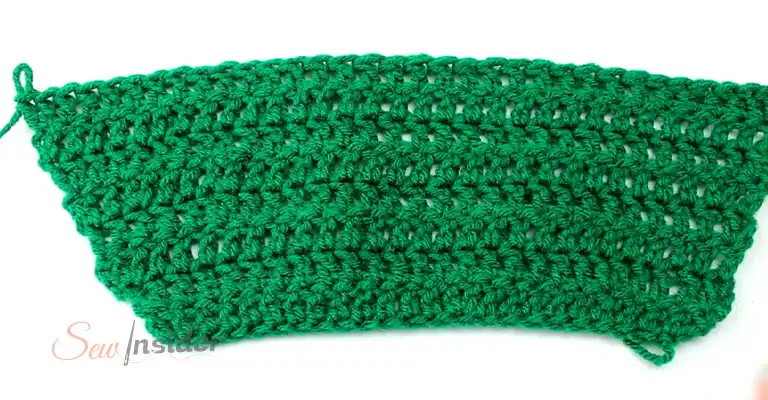If you are new to crocheting projects, one of the common issues you’ll experience here is the curviness of the blanket. At some point, you may even ask yourself, why is my crochet blanket curving? Because blankets are supposed to have straight edges.
When you start seeing your crochet blanket getting rainbow edges, it can make you panic as you don’t understand why it is happening. However, curving is a very common thing for a crochet blanket, and there are some specific reasons for that. We will examine the reasons for this curving and discover ways to resolve this problem in this article.

What Is A Crochet Blanket?
The crochet blanket is a type of blanket used most commonly by stitchers. Its versatile structure is one of the reasons for its popularity. You’ll be amazed to know that a crochet blanket can be made using any stitch pattern and various yarns of different sizes and weights. So, you can either make a tiny baby blanket or a large one.
Crafting a crochet blanket is simple, and you can use it to keep yourself cozy and have a good feeling. Of course, crochet refers to the process of creating a textile using a crochet hook, but a crochet blanket is an output product after crocheting the materials. When you want to make a gorgeous afghan, crocheting is the best option for your textile.
Reasons Behind Why Crochet Blanket Curving?
A serious project in this world cannot be completed without challenges. So, when you are crocheting your blanket, it is common to face challenges like getting the curving edges. In this scenario, the pleasing rectangles of your crochet blanket transform into curving edges, creating a rainbow look. In particular, there are two reasons for such curving problems, and these are explained below.
1. Uneven Number Of Stitches
Adding extra stitches to the project can be the reason for curving the crochet blanket. Sometimes, you may crochet the blanket tightly, and the stitches will look uneven. In such a condition, most people try to add more stitches to the tight zones and make them flat. But the result is obvious: you’ll get the curving in your crochet blanket most of the time.
2. Tension In Crocheting
If your stitches are too tight in your blanket, there is no chance that you can avoid the curving. Rather, the whole blanket will start curving. For instance, when you cast your row tightly, it will begin to curve eventually.
These curves are the result of tension among the stitches. This is because each stitch has a different degree of tightness. You may get some parts of the blanket with tighter stitches and other parts with looser ones. Thus, the whole setup creates inconsistent tension and gets curving in it.
How To Avoid Crochet Blanket Curving
Now you know the reasons why your crochet is curving, and there is not much to do after getting the curves. But, can you prevent it in the first place before happening? Yes, it’s entirely possible if you follow some specific techniques. So, we warmly advise you to read the following solutions to get relief from this curving problem.
1. Blocking
Mainly, blocking is a task that is usually done at the end of a crochet blanket project. To perform this task, you need to wet your blanket and stretch it to your desired size or shape. After that, dry it by keeping it stable in that shape.
Furthermore, there are three ways to get your crochet blanket. Steaming can be the best if you have a steaming tool available. Otherwise, you mist or wash it before stretching. Don’t forget to pin it after stretching to keep it stable. However, the end result may not always be the same due to different types of yarns and perfect stretching. So, you can repeat the process until you get your desired position.
2. Ripping the Previous Row
We suggest this technique only if you fail to prevent the curving when crocheting at the same time. Usually, the method is called frogging, as you need to redo your previous work by ripping apart. First, you must identify the last correct stitch and unravel the whole curving zone stitches. Then, repeat the crocheting with correction.
2. Adding A Border
If you face a minor curving situation at the end of your project, you can use this technique and add a border instead of frogging again and again. In such a condition, you need to adjust the row size for your border and use the same yarn with separate colors to make the border. Sometimes, you may need extra stitches to complete the project straight on the shortest side.
3. Using As Design
Specifically, you can use this technique as a trick to cover your curving mistakes. That means you’ll actually use the curving as a design element instead of trying to solve it. In this way, your previous efforts won’t be undermined, as you’ll use them as an asset to your design process.
This solution works only in the early stages of your project. Because you need to replicate the number of stitches just like the previous ones that caused the curving. So, you can’t follow it if you’ve gone far with your project.
Conclusion
As a crocheter, it is ubiquitous to experience challenges with projects. Because these types of projects are very sensitive, you cannot always avoid mistakes. However, you have nothing to worry about as a number of solutions are awaiting in most cases. In the long run, since you know the reasons for your crochet blanket curving, we recommend preventing the mistakes first. However, if curving is still a concern for your project, consider the above techniques.
Leave a Reply